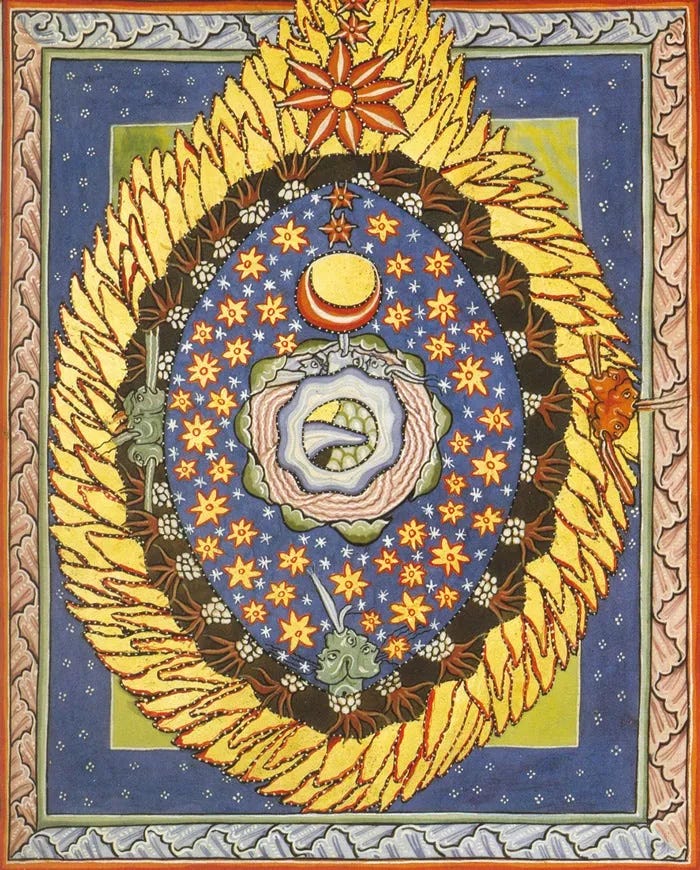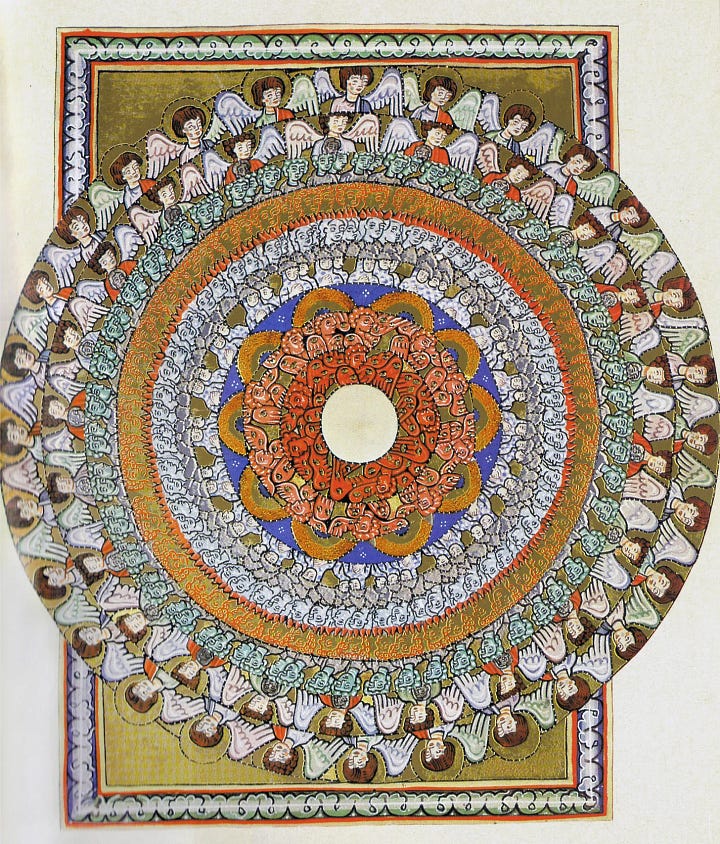Hildegard von Bingen; (historicalwomen.1)
Hildegard of Bingen, Hildegardis Bingensis, Sibyl of the Rhine
Many historical women’s interwoven stories, livelihoods, and creative contributions have amalgamated into a vast blanket innately representative of the power in the pursuit of one’s passions - alignment of self; a blanket intended for those observing it to soak in the niches and complexities of its patterns; to contemplate the nature of the needle and thread that never ceases to hum a song of stories connected throughout the fabric of time.
A few embroidered elements upon these fabrics have readily stood out, the stories they sowed for women centuries before and after them calling me to traverse the line between mere acknowledgment and a greater depth of appreciation. With creativity and adjacent curiosity having left subtle marks upon my soul as innate to how I perceive and understand, the women who recurrently appear in my conscious and subconscious alike are those who hold vibrant stories of living unafraid of one’s passions and self. One of these women, Hildegard von Bingen (Hildegard of Bingen, Hildegardis Bingensis, Sibyl of the Rhine), has remained a consistent interest and inspiration of mine.
A German Benedictine abbess, polymath, writer, musical composer, philosopher, natural historian, medical writer and practitioner, mystic, and visionary, Hildegard lived during the High Middle Ages of Germany. She was born c. 1098 in Bermersheim vor der Höhe (County Palatine of the Rhine, Holy Roman Empire) of lower nobility. She recounted experiencing visions and spiritual awakenings, interpretations strikingly early in life. By late childhood, Hildegard was offered as an oblate at the Benedictine monastery at Disibodenberg, alongside Countess Jutta von Sponheim - whose care she was placed in. When Jutta passed in 1136, Hildegard was elected as magistra - that is, before abbot Kuno of Disibodenberg elected her to be prioress. Hildegard negotiated increased independence for herself and her fellow nuns - manifesting in a relocation and establishment of her own monastery, becoming an abbess. Before her death, Hildegard founded a second monastery at Eibingen. Venerated after her passing in 1179, Hildegard von Bingen was applied for the canonization process, was established at a level of beautification, was officially included within the Roman Martyrology, and has been referred to as a saint amongst being added to the General Roman Calendar. She is also known as a Doctor of the Church.
Within and between these phases of life, Hildegard paved the way not just for women and their innate capabilities in the fields unaccepting of those residing outside strict binaries, but for her broader communities and society as a whole. A notable consistency throughout Hildegard’s life was her experiencing of visions, or ‘The Shade of the Living Light’ (metaphor for divine interpretations), leading her to compose and arrange a collection of works pertaining specifically to visionary theology. Symbolizing the importance of journaling and documentation for spiritual creatives, Hildegard began her works by simply writing on profound experiences, later sharing that she had received an instruction from God to ‘write down that which you see and hear’ - despite all adversity; perhaps to be interpreted as a calling to dedicate time and space to the creative inspiration one spontaneously receives. Hildegard’s visions are more inextricably linked with her artistic pursuits than is often assumed, and speak to a broader appreciation of how essential it is to embrace creative curiosity and the radicle nature of making art outside the confines of productivity or the ‘right time’.
Hildegard von Bingen delicately traversed the line between composing music relevant to her time and pioneering unique interpretations of those same compositional styles and motifs. Often composing for the stage, her multitude of compositions amount to an impressive portfolio of creative works, with Ordo Virtutum - an allegorical morality play and sacred music drama - being one of Hildegard’s most renowned musical pieces. Within the Ordo Virtutum, religious contemplations of sin, repentance, and forgiveness are approached - demonstrating the value art holds in representing and expressing broader human contemplations and collective issues. Her liturgical songs - collected primarily into the Symphonia armoniae celestium revelationum - span a large range of musical interpretations, including antiphons, hymns, and responsories. These expansions of the outer bounds of traditional Gregorian chant are aligned with perhaps the largest motif of Hildegard’s creative work - experimentation.
Hildegard’s physical art pieces have been known to interpret or represent her mystical visions, with Scivias, a collection of illustrations with accompanying writings addressing these complex visionary experiences, perhaps being one of her most monumental publications. Along with ‘The Choirs of Angels’ depicted in the gallery below, a personal favorite, ‘The Universe’ is shown, depicting the cosmos through an inherently experimental and spiritual lens, interpreting the stars and universe as receptive of the word of God, as well as the origins of art and life.


Beyond artistic expression, Hildegard’s contributions to the world of science and medicine are notably profound. Although thematically complimentary to her visionary pieces, Hildegard’s research was often rooted in the same experience and wisdom that gained her the title of spiritual healer. In terms of catalogued theories, Physica and Causae et Curae explore her careful study of the natural world’s medical properties. These books hold additional historical significance in that their field of medieval medicine is scarcely recorded in Latin, as their primary practitioners and healers were women (with comparably scarce access to literary education). A hallmark of Hildegard’s scientific writing is its emphasis on human interconnectedness with the cosmos, as well as how bodily and spiritual healing are innately complimentary. She alludes to the symbiosis and balance between organisms essential in maintaining wellness, and the vital connection between the health of the natural world and the health and well-being of the individual.
Hildegard von Bingen transformed medieval composition, offered profound spiritual insights that shaped religious thought, and made significant advancements in a plethora of scientific, artistic, and medical fields. One must also stay soundly separated from overlooking how every administered piece of art, every published collection of works, every statement made by Hildegard occurred adjacent to the Catholic Church having exiguous respect for women. Her passion for pushing past the boundaries and binaries implemented disproportionately in the arts and sciences inspired many - both within her communities and far beyond - even reaching a young woman in 2025 sitting at her desk while eating a granola bar(!)
“I am the fiery life of the essence of God; I am the flame above the beauty in the fields; I shine in the waters; I burn in the sun, the moon, and the stars. And with the airy wind, I quicken all things vitally by an unseen, all-sustaining life.” - Hildegard von Bingen
“Dare to declare who you are. It is not far from the shores of silence to the boundaries of speech. The path is not long, but the way is deep. You must not only walk there, you must be prepared to leap.” - Hildegard von Bingen
“We cannot live in a world interpreted for us by others. An interpreted world is not a hope. Part of the terror is to take back our listening, to use our own voice, to see our own light.” - Hildegard von Bingen
References -
https://sciencenetwork.uk/think/hildegard-of-bingen
https://westminsterabbey.ca/wp-content/uploads/2018/07/Selected-Writings-Hildegard-of-Bingen-Mark-Atherton.pdf
https://www.amodernreveal.com/hildegard-von-bingen#:~:text=Her%20composition%20Ordo%20virtutum%20(c,performed%20outside%20of%20her%20convent.
https://en.wikipedia.org/wiki/Hildegard_of_Bingen
https://www.njmastro.com/post/sybil-of-the-rhine-the-story-of-saint-hildegard-von-bingen





